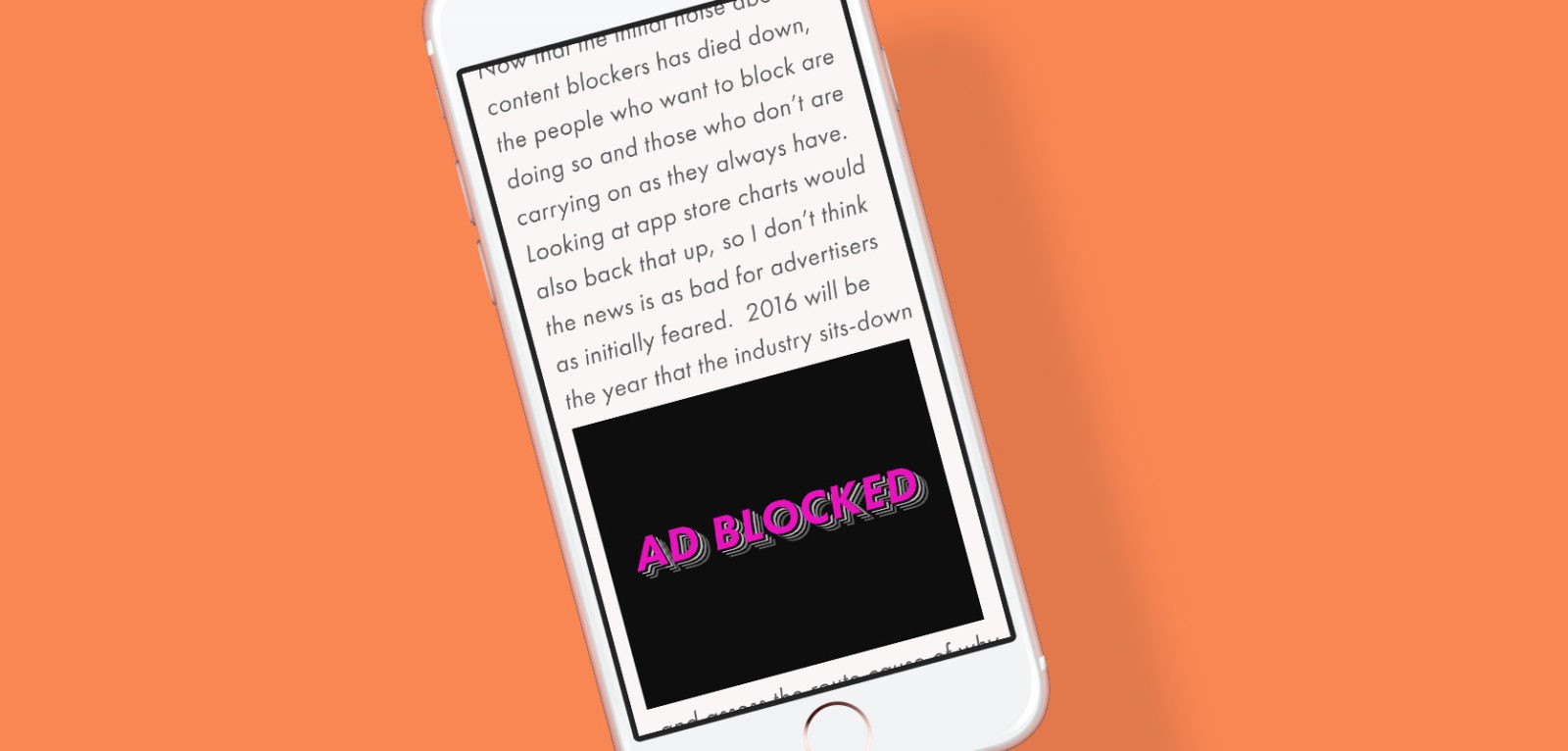
Creative 2016 Predictions
Its that time of the year when the industry tries to predict what the future might hold. Creative is tricky to predict, especially design. I truly value, original, creative thinking. Trends tend to clone an original concept or look and feel and apply it to something whilst lacking insight. So my predictions follow technical developments of the past year or so and how their evolution can further develop digital creativity.
Ad Blocking – A response from the industry
I think that the hot topic in digital marketing during 2015 would certainly be ad blocking. Ad blocking is nothing new dating back to popup blockers in the early 2000’s, but Apple enabled developers to create ‘Content blockers’ for the first time for iOS9 on iPhone and iPad. This put ad blocking into the mainstream news, where it has once only been used by tech savvy users. Content blockers aren’t specifically Ad blockers – they can give a developer the option to target something on a webpage and prevent it from loading. This could be disabling webfonts, images, css and much more. Billed as a way for users to speed up web browsing, by switching off elements they think are compromising performance, helping increase battery life whilst minimising expensive mobile data used. On day one of iOS9 launch, content blockers (of ad blocking variety) filled both free and paid for charts on the app store. Alarm bells rang throughout the industry.
Now that the initial noise about content blockers has died down, the people who want to block are doing so and those who don’t are carrying on as they always have. Looking at app store charts would also back that up, so I don’t think the news is as bad for advertisers as initially feared. 2016 will be the year that the industry sits-down and assess the route cause of why users feel the need to block ads though. People are used to accessing the internet for free, with little care for content creation and hosting costs and pay-walled sites haven’t been hugely popular, so there is definitely space for a compromise. As a consequence I do think there will be an increase of higher quality targeted advertising, implemented with a ‘mobile first’ mindset which puts users, their devices and data plans front and centre.
Digital Payments go mainstream
Both Apple and Google launched digital wallets in 2015 and we are moving ever closer to being a cashless (ticketless) society. I have started to embrace this myself and pay for my commute to and from work every day with my Apple Watch, (I still try not to be noticed whilst doing it!) its convenient and one less thing to carry around every day. By 2020, paper tickets will be a thing of the past on the UK rail network. 2016 will see this mindset develop further, with peer-to-peer payments to become the norm. Services like Transferwise for international transfers, Dice for gig tickets, the Trainline’s mobile tickets etc. will further encourage us to leave our wallet at home. As the mobile becomes our primary wallet, I’m excited to see more and more products and services spring up and further take advantage of this.
VR
Virtual Reality is nothing new, but the affordability of headsets such as Occulus Rift and Google Cardboard, which upgrades any modern smartphone into a VR headset have now made it a much more appealing medium. Although the headsets aren’t particularly practical I think 2016 will be the year VR becomes a viable product, particularly because of 360 videos, which are now supported natively on the Facebook app, they also don’t require a headset. Here are a couple of my favourite 360 videos from last year:
Nike Football – The Neymar Jr. Effect
Foals – Mountain At my Gates
I think VR/360 video will enable content creators to go to town with new and exciting ways to build campaigns, from Fashion shows, exhibitions, product to live sports. The prospect of watching live events in 360 is exciting. Imagine the possibilities if it was an Olympic year…
Olympic Games
Following that neat segue the Olympic Broadcast Services, which is the division of the IOC that manages broadcast rights have shown an interest in trialing VR at this years games in Rio.
If London 2012 was billed as the first ‘Digital’ Olympic Games, with the BBC showing every moment of the event via live TV, the red button, dedicated mobile app and their website, then Rio 2016 should take things further now that second screening is now common place. Apps like BT Sports Champions League coverage provides a much richer experience, giving the viewer the option to choose between any game and see live stats alongside as well as access to watch key highlights on demand.
I would love to see that kind of deep integration during the Olympics. Being able choose any event at any time, plus have access to replays, medal tables, athlete stats, rules for each sport as well as being able to tweet and share content would offer a compelling viewer experience.
Personal predictions (hopes)
Subtlety in webdesign
Following the backlash against skeuomorphisim 3 or 4 years ago the visual pendulum swung firmly to the other direction in favour of ‘flat’ design. Whilst this trend looked completely different compared to everything users were used to (and in the process, making all sites look dated), designers were turning the dial up to 11, creating websites that put style above the needs of users. Fortunately the dial has started to settle somewhere closer to usable with visual affordance accounted for.
But with all new design trends, designers get carried away and overuse until finally reaching a refined moment of subtlety. For me we have now reached that point with over use of animated elements of webpages, the worst case of this being scroll-jacking, where the website overrides the scroll.
I would love to see this end in 2016.




